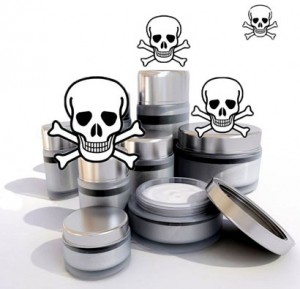20 toxic ingredients to avoid when buying body care products and cosmetics.
 Labels on cosmetics and body care products are a tough code to crack. The industry is so shockingly unregulated that it’s usually impossible to trust the claims that manufacturers place on their products. A word such as “natural” can be used by anyone for anything. Even “organic” is misleading. Companies are supposed to use an organic label only if all ingredients are certified-organic, but they can also say it’s “made with organic” if it contains a minimum of 70 percent certified-organic ingredients. Regardless, 30 percent still leaves a lot of room for toxins.
Labels on cosmetics and body care products are a tough code to crack. The industry is so shockingly unregulated that it’s usually impossible to trust the claims that manufacturers place on their products. A word such as “natural” can be used by anyone for anything. Even “organic” is misleading. Companies are supposed to use an organic label only if all ingredients are certified-organic, but they can also say it’s “made with organic” if it contains a minimum of 70 percent certified-organic ingredients. Regardless, 30 percent still leaves a lot of room for toxins.
The whole industry has a “innocent-till-proven-guilty” approach to ingredients. Unless a chemical used in beauty products is proven to cause harm to human health, it is classified as GRAS, or “generally recognized as safe.” This classification is upheld by the U.S. FDA and hardly has the best interests of consumers at heart.
The best thing we consumers can do is read ingredient lists carefully in order to avoid chemicals that are known to be harmful, even though they continue to be widely used. Here is a list of the top 20 toxins to avoid, according to Gillian Deacon’s 2011 book There’s Lead in Your Lipstick: Toxins in Our Everyday Body Care and How to Avoid Them.
Coal Tar: A known carcinogen banned in the EU, but still used in North America. Used in dry skin treatments, anti-lice and anti-dandruff shampoos, also listed as a colour plus number, i.e. FD&C Red No. 6.
DEA/TEA/MEA: Suspected carcinogens used as emulsifiers and foaming agents for shampoos, body washes, soaps.
Ethoxylated surfactants and 1,4-dioxane: Never listed because it’s a by-product made from adding carcinogenic ethylene oxide to make other chemicals less harsh. The Environmental Working Group (EWG) has found 1,4-dioxane in 57 percent of baby washes in the U.S. Avoid any ingredients containing the letters “eth.”
Formaldehyde: Probable carcinogen and irritant found in nail products, hair dye, fake eyelash adhesives, shampoos. Banned in the EU.
Fragrance/Parfum: A catchall for hidden chemicals, such as phthalates. Fragrance is connected to headaches, dizziness, asthma, and allergies.
Hydroquinone: Used for lightening skin. Banned in the UK, rated most toxic on the EWG’s Skin Deep database, and linked to cancer and reproductive toxicity.
Lead: Known carcinogen found in lipstick and hair dye, but never listed because it’s a contaminant, not an ingredient.
Mercury: Known allergen that impairs brain development. Found in mascara and some eyedrops.
Mineral oil: By-product of petroleum that’s used in baby oil, moisturizers, styling gels. It creates a film that impairs the skin’s ability to release toxins.
Oxybenzone: Active ingredient in chemical sunscreens that accumulates in fatty tissues and is linked to allergies, hormone disruption, cellular damage, low birth weight.
Parabens: Used as preservatives, found in many products. Linked to cancer, endocrine disruption, reproductive toxicity.
Paraphenylenediamine (PPD): Used in hair products and dyes, but toxic to skin and immune system.
Phthalates: Plasticizers banned in the EU and California in children’s toys, but present in many fragrances, perfumes, deodorants, lotions. Linked to endocrine disruption, liver/kidney/lung damage, cancer.
Placental extract: Used in some skin and hair products, but linked to endocrine disruption.
Polyethylene glycol (PEG): Penetration enhancer used in many products, it’s often contaminated with 1,4-dioxane and ethylene oxide, both known carcinogens.
Silicone-derived emollients: Used to make a product feel soft, these don’t biodegrade, and also prevent skin from breathing. Linked to tumour growth and skin irritation.
Sodium lauryl (ether) sulfate (SLS, SLES): A former industrial degreaser now used to make soap foamy, it’s absorbed into the body and irritates skin.
Talc: Similar to asbestos in composition, it’s found in baby powder, eye shadow, blush, deodorant. Linked to ovarian cancer and respiratory problems.
Toluene: Known to disrupt the immune and endocrine systems, and fetal development, it’s used in nail and hair products. Often hidden under fragrance.
Triclosan: Found in antibacterial products, hand sanitizers, and deodorants, it is linked to cancer and endocrine disruption. Avoid the brand Microban.
All the FM GROUP products, based on herbal ingredients!
